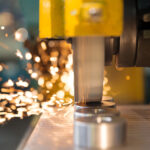The importance of Additive Manufacturing grows every year with the increasing share of this
technology in the market. Complex and efficient geometries can be designed, costly part
tooling is eliminated and much shorter development times are part of the advantages in AM.
However, time to develop a new material and quality consistency keep on being today’s
challenges in this technology. Overcoming these issues will allow for a faster adoption of AM
in more significant and meaningful applications (e.g. aerospace, automotive, medical).
The Grindosonic MK7 can aid into different areas of Additive Manufacturing. Either if we talk
about quality consistency, a new material adoption or quality improvement, the MK7 is the
perfect tool for a robust, high-speed, accurate and precise determination of the mechanical
properties under study.
Material characterization
Material characterization by IET is a well known technology (described in the ASTM E 1876
standard) that by tapping a material it allows to determine the Young’s Modulus, Shear
Modulus and Poisson’s Ratio which also leads to a fast-to-market new product introduction
in terms of a new material for most AM technologies.
Process parameters
Process parameters can be tuned for a specific material, technology or application, but due
to a non uniform energy deposition, the results are not always consistent. Mapping the
frequency signature of every printed part, for every specific material, helps the user to
correlate these process parameters with the mechanical properties of the aforementioned
material, leading like this into improving and further tuning the printing process for an optimal
result.
Moreover, the printing conditions of a machine can also be monitored by using reference
samples and testing them with a Grindosonic MK7, aiming for repeatable frequency
signatures which show a constant state of the machine.
Post processing methods
Post processing methods are often utilized in AM, either to reduce internal stresses, diminish
porosity or reduce superficial imperfections. With the MK7, a control in between processes
can be performed, resulting in a confirmation of the benefit from those processes or to help
improve them.
Consistency
Despite the benefits of AM, there are various factors that restrain its full adoption as a
standard manufacturing process. Consistency during printing or adopting a new material in
order to increase the significant low choice for AM are among the reasons why this
technology cannot fully yet replace conventional manufacturing (CM). The Grindosonic MK7
can gauge the difference between AM and CM initially by comparing their frequencies and
further on analyzing their spread among properties in printed parts, in combination with the
Grindosonic Waterfall Spectrogram.
It is beyond doubt that the advantages and possibilities of using the Grindosonic MK7 are a
perfect match to aid into a faster adoption of AM as well as having a keen eye into the
quality deliverables of this promising technology.



